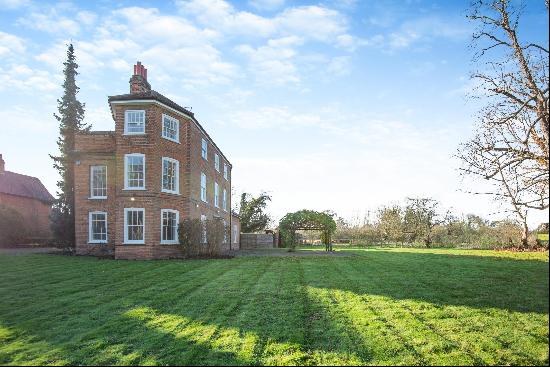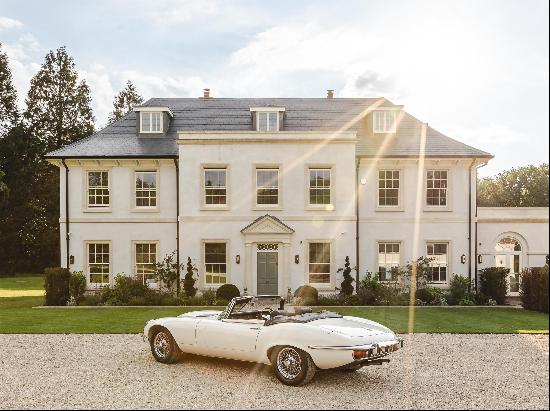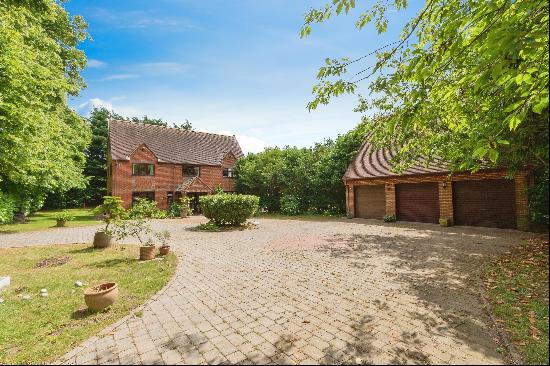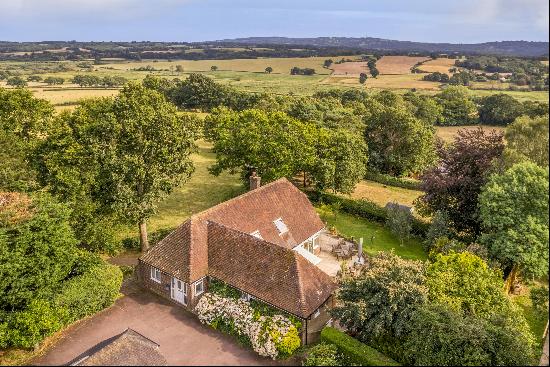













- For Sale
- Guide price 10,000,000 GBP
- Build Size: 10,422 ft2
- Land Size: 12,398 ft2
- Bedroom: 7
- Bathroom: 8
A Grade II listed masterpiece in the classic Arts and Crafts tradition, recently refurbished by the award- winning acclaimed interior and architectural designers, Tollgard Design.
Drummers Yard, originally named Birchens Spring, is widely regarded as one of the most important houses in the Beaconsfield area. It is one of the most important of its type and one of the first houses in the country to be awarded listed status. Built in 1938 by the celebrated architect John Campbell for Mr Rissik, the house is of whitened brick under a Cornish slate roof with distinctive chimney stacks. It represents the high water mark of the Arts and Crafts movement with many traditional interior features of the period with catslide roofs and brick arches. With its conical tower, it has the appearance of a Scottish castle, whilst also displaying features of an Italian villa. Whilst appealing to architectural purists, the house will equally suit families looking for a comfortable, well laid-out home. Campbell intended for each room to have at least two garden elevations, ensuring the house is light, bright and airy with exceptional views of the gardens.John Campbell was an architect of great skill and originality, a slightly younger contemporary of Sir Edwin Lutyens and Charles Rennie Mackintosh, who has remained almost unknown. While Lutyens and Mackintosh mainly contributed to architecture before 1914, Campbell's work was only presented to the English public in 1938 when Drummers Yard was published in Country Life. Campbell was unknown because he was in Germany for much of his career, both from 1902-1914 and 1929-1931. Campbell made a personal blend of German and English influences which Christopher Hussey, writing in Country Life, recognised as a possible middle way between tradition and modernism in architecture.Campbell had many theories which made his designs cohere. He used a seven foot module and divided the mass of the building to give each room a separate roof ridge, demonstrating his ideas at Chapel Point, Mevagissey, where he developed three houses on a beautiful headland, similarly to Drummers Yard but on a smaller scale. Having just posted the papers for a planning appeal to continue the development, he died unexpectedly, falling from the cliff on his way back to Chapel Point; this was typical of his life's bad luck which prevented his work from gaining the wider interest Hussey predicted, but it will undoubtedly be admired as it becomes better known. Dirk Bogarde owned and lived in the house and mentioned it in his memoirs.Summary of accommodation:The house is beautifully proportioned with exceptional rooms. On the ground floor, entrance hall with brick and stone arched ceiling leads into the sun room; a lovely light room overlooking the gardens, with sliding doors onto the terrace. Off the hall is a circular dining room. A corridor with murals of Hyde Park leads to the study with a mini kitchen and mezzanine. Drawing room with double height ceilings, tall windows and an unusual pyramid fireplace. Kitchen by Sola, the Swedish designer. Cloakroom, cellar and boiler room with gas fired boiler, Butler's pantry, kitchen with a small breakfast room through to laundry and WC.On the first floor, the original staff wing is now well laid out for guest accommodation with a bedroom suite, adjacent child's bedroom, family bathroom and main guest bedroom with en suite bathroom. Landing with access to master bedroom, an impressive double aspect bedroom with en suite dressing room and bathroom. Staircase hall leading to a bedroom suite with en suite shower bathroom and dressing room. Further bedroom with Juliet balcony and four arched windows overlooking the garden and terrace below. Flight of stairs leads to the tower with a children's bedroom with en suite shower and bathroom.The house has a two car garage and courtyard, and a gymnasium with sauna and steam room. It is set in beautifully presented gardens and grounds of about
Drummers Yard, originally named Birchens Spring, is widely regarded as one of the most important houses in the Beaconsfield area. It is one of the most important of its type and one of the first houses in the country to be awarded listed status. Built in 1938 by the celebrated architect John Campbell for Mr Rissik, the house is of whitened brick under a Cornish slate roof with distinctive chimney stacks. It represents the high water mark of the Arts and Crafts movement with many traditional interior features of the period with catslide roofs and brick arches. With its conical tower, it has the appearance of a Scottish castle, whilst also displaying features of an Italian villa. Whilst appealing to architectural purists, the house will equally suit families looking for a comfortable, well laid-out home. Campbell intended for each room to have at least two garden elevations, ensuring the house is light, bright and airy with exceptional views of the gardens.John Campbell was an architect of great skill and originality, a slightly younger contemporary of Sir Edwin Lutyens and Charles Rennie Mackintosh, who has remained almost unknown. While Lutyens and Mackintosh mainly contributed to architecture before 1914, Campbell's work was only presented to the English public in 1938 when Drummers Yard was published in Country Life. Campbell was unknown because he was in Germany for much of his career, both from 1902-1914 and 1929-1931. Campbell made a personal blend of German and English influences which Christopher Hussey, writing in Country Life, recognised as a possible middle way between tradition and modernism in architecture.Campbell had many theories which made his designs cohere. He used a seven foot module and divided the mass of the building to give each room a separate roof ridge, demonstrating his ideas at Chapel Point, Mevagissey, where he developed three houses on a beautiful headland, similarly to Drummers Yard but on a smaller scale. Having just posted the papers for a planning appeal to continue the development, he died unexpectedly, falling from the cliff on his way back to Chapel Point; this was typical of his life's bad luck which prevented his work from gaining the wider interest Hussey predicted, but it will undoubtedly be admired as it becomes better known. Dirk Bogarde owned and lived in the house and mentioned it in his memoirs.Summary of accommodation:The house is beautifully proportioned with exceptional rooms. On the ground floor, entrance hall with brick and stone arched ceiling leads into the sun room; a lovely light room overlooking the gardens, with sliding doors onto the terrace. Off the hall is a circular dining room. A corridor with murals of Hyde Park leads to the study with a mini kitchen and mezzanine. Drawing room with double height ceilings, tall windows and an unusual pyramid fireplace. Kitchen by Sola, the Swedish designer. Cloakroom, cellar and boiler room with gas fired boiler, Butler's pantry, kitchen with a small breakfast room through to laundry and WC.On the first floor, the original staff wing is now well laid out for guest accommodation with a bedroom suite, adjacent child's bedroom, family bathroom and main guest bedroom with en suite bathroom. Landing with access to master bedroom, an impressive double aspect bedroom with en suite dressing room and bathroom. Staircase hall leading to a bedroom suite with en suite shower bathroom and dressing room. Further bedroom with Juliet balcony and four arched windows overlooking the garden and terrace below. Flight of stairs leads to the tower with a children's bedroom with en suite shower and bathroom.The house has a two car garage and courtyard, and a gymnasium with sauna and steam room. It is set in beautifully presented gardens and grounds of about





















